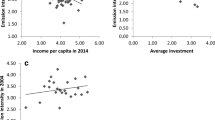Abstract
The Kyoto Protocol on climate change includes four flexibility mechanisms, which pursue lower-cost global reduction of greenhouse gas emissions through voluntary international re-distribution of abatement effort. We consider the operation of one of these, the Clean Development Mechanism (CDM), which grants transferable credit for abatement achieved by individual projects in countries without national emission targets. An uncredited pilot phase in effect since 1995 provides only limited guidance for projecting the operation of the credited CDM. Under the CDM, intractable difficulties of accounting for project-level effects are likely to bias project activity toward particular project types for which exaggeration-resistant accounting rules are most readily available. This bias will favor retrofits over new investments, and will consequently limit the CDM to a modest contribution to required abatement in developing countries. Use of CDM credits as instruments of domestic policy in investor countries, as well as instruments of international policy, may mitigate this bias and the associated limitation. So may the use of projects based on novel technologies of carbon management.
Similar content being viewed by others
References
Anderson, R. J. Jr. (1995). Joint Implementation of Climate ChangeMeasures. Environment Department Papers, Climate Change Series, Paper No. 005.Washington, DC: TheWorld Bank.
Center for Clean Air Policy (1997). Proceedings of JI International Meeting, 14–15 October, Annapolis Md. Center for Clean Air Policy.
'The discussion on flexible instruments in 4000 words,’ JI Quarterly 4: 3, September 1998, Paterswolde, the Netherlands.
Dower, R.C. (1996). ‘Carbon sequestration and lessons for joint implementation.’ Presentation to the meeting, ‘Joint implementation in North America: Opportunities for regional cooperation.' Mexico City.
Edmonds, J., M. Wise and D.W. Barns (1995). ‘Carbon coalitions: The cost and effectiveness of energy agreements to alter trajectories of atmospheric carbon dioxide emissions,’ Energy Policy 23 (4/5): 309–335.
Fairman, D. (1996). ‘The global environment facility: Haunted by the shadow of the future,’ in R.O. Keohane and M. A. Levy, eds., Institutions for Environmental Aid. Cambridge, MA: MIT Press.
Goldemberg, J., ed. (1998). Issues and options: The clean development mechanism. NewYork, NY: United Nations Development Programme.
Gupta, J. (1996). Joint implementation: Between hope and angst. Discussion paper. Amsterdam: Center for Environmental Studies, Free University.
Hamwey, R.M. (1998). ‘A sustainable framework for joint implementation,’ International Environmental Affairs 10 (2): 79–97.
Harvey, L.D.D. and E. Bush (1997). ‘Joint implementation: An e¡ective strategy for combating global warming?’ Environment 39 (8): 14–20, 36–44.
Hoffert, M. I. et al. (1998). ‘Energy implications of future stabilization of atmospheric CO2 content.’ Nature 395 (29): 881–884.
Jepma, C. J. and M.-J. Eisma (1998). General discussion of the AIJ reporting system. Foundation JIN: Paterswolde, the Netherlands.
Jones, T. (1994). ‘Joint implementation as a policy instrument for responding to climate change,’ in A. Amano et al., eds., Climate Change: Policy Instruments and Their Implications. Tsukuba: Center for Environmental Policy Research.
Kureya, T. A. (1996). Activities Implemented Jointly (AIJ) or Joint Implementation (JI): Carbon Colonies or Business Opportunities? Harare, Zimbabwe: Southern Center for Energy and Environment.
Manne, A. S., R. Mendelsohn and R.G. Richels (1993). Energy Policy 23 (1): 17–34. MERGE: A Model for Evaluating Regional and Global Effects of GHG Reduction Policies.
Mintzer, I.M. (1994). Institutional options and operational challenges in the management of a joint implementation regime. Silver Spring, MD: Stockholm Environment Institute.
Mitchell, R. B. and E. A. Parson (1998). ‘Implementing joint implementation: Developing a management and performance system for the Kyoto protocol's 'clean development mechanism.’ E-98–06. Cambridge, MA: Environment and Natural Resources Program, Belfer Center for Science and International Affairs.
Oliveira-Martins, J., J.-M. Burniaux, J. P. Martin and G. Nicoletti (1992). ‘The costs of reducing CO2 emissions: A comparison of carbon tax curves with green.’ OECD Econ. DepartmentWorking Papers No. 118, OECD, 1–54. Paris, France: OECD.
Parson, E. A. and D.W. Keith (1998). ‘Fossil fuels without CO2 emissions,’ Science 282 (6): 1053–1054.
Parson, E. A. and K. Fisher-Vanden (1997). Joint Implementation and Its Alternatives: Choosing Systems to Distribute Global Emissions Abatement and Finance. Discussion Paper E-97–02. Cambridge, MA: Belfer Center for Science and International A¡airs, Harvard University.
Parson, E. A. and R. Zeckhauser (1995). ‘The unbalanced commons: Climate change and other international environmental problems of collective action,’ in K. Arrow et al., eds., Barriers to the Negotiated Resolution of Conflict. NewYork: Norton.
'Planned and ongoing AIJ projects’ (1998). JI Quarterly 4 (3): 14, Paterswolde, the Netherlands.
Roland, K. and T. Haugland (1994). Joint Implementation: Di¤cult to Implement? Economics, Energy, and Development Working Paper 7. Oslo: The Fridtjof Nansen Institute.
Shukla, P.R. (1996). When and Where Aspects of Climate Change Mitigation Actions: A Developing-Country Perspective. Paper presented to the IPCC symposium on ‘Lessons learned from the IPCC as an integrated assessment process,' Toulouse, France, 24–26 October. Ahmedabad: Indian Institute of Management.
Sughandy, A. (1996). ‘Interview with assistant minister for policy formation, environment division, government of Indonesia,’ JI Quarterly 2 (2).
Tietenberg, T. and D. Victor (1994). ‘Possible administrative structures and procedures for implementing a tradable entitlement approach to controlling global warming,’ in Combating Global Warming. NewYork: United Nations Conference on Trade and Development.
Vellinga, P. and R. J. Heintz (1994). ‘Joint implementation: A phased approach,’ in Criteria for Joint Implementation Under the Framework Convention on Climate Change. Report of a workshop held 9–11 January 1994, Southampton, Bermuda. Woods Hole, MA: Woods Hole Research Center.
Watt, E. and J. Sathaye (1994). The Institutional Needs of Joint Implementation Projects. In collaboration with O. de Buen et al. Berkeley, CA: Lawrence Berkeley Laboratory.
Wexler, P., I. Mintzer, A. Miller and D. Eoff (1994). ‘Joint implementation: Institutional options and implications.’ College Park, Maryland: Center for Global Change, University of Maryland.
Weyant, J. et al. (1996). ‘Integrated assessment of climate change: An overview and comparison of approaches and results,’ in J. P. Bruce, H. Lee and E. F. Haites, eds., Climate Change 1995: Economic and Social Dimensions of Climate Change. Contribution of Working Group III to the Second Assessment Report of the Intergovernmental Panel on Climate Change. Cambridge: Cambridge University Press.
UN Framework Convention on Climate Change (1998). ‘Review of the implementation of commitments and of other provisions of the convention: Activities implemented jointly: Review of progress under the pilot phase.’ Note by the secretariat, 2 October. FCCC/CP/1998/2.
UN Framework Convention on Climate Change (1997a). ‘Kyoto protocol to the UN framework convention on climate change,’ 10 December. FCCC/CP/1997L.7/Add.1.
UN Framework Convention on Climate Change (1997b). ‘Activities implemented jointly under the pilot phase: Synthesis report on activities implemented jointly, report by the secretariat.’ Note by the secretariat, 7 October. FCCC/SBSTA/1997/12.
Author information
Authors and Affiliations
Rights and permissions
About this article
Cite this article
Parson, E.A., Fisher-Vanden, K. Joint implementation of greenhouse gas abatement under the Kyoto protocol's ‘clean development mechanism’: Its scope and limits. Policy Sciences 32, 207–224 (1999). https://doi.org/10.1023/A:1004612911638
Issue Date:
DOI: https://doi.org/10.1023/A:1004612911638




